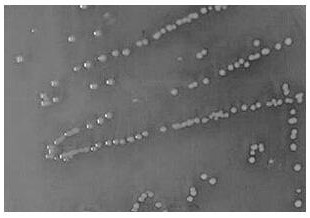Pig-source lactobacillus mucosae and application thereof
A technology of mucosal lactobacillus and porcine origin, applied in the field of microorganisms, can solve the problems of effect effects and other problems, and achieve the effect of good in vitro probiotic potential
- Summary
- Abstract
- Description
- Claims
- Application Information
AI Technical Summary
Problems solved by technology
Method used
Image
Examples
Embodiment 1
[0028] Example 1, Lactobacillus mucosa Lactobacillus mucosae Isolation and identification of
[0029] 1. Isolation and purification of strains
[0030] Take about 0.5g of the feces sample of healthy cooperative pigs and dilute it with 1×DPBS buffer solution to 10 -3 、10 -4 、10 -5 3 gradients. Take 70.00 µL of feces dilutions of different concentrations and smear them on CaCO2 containing vancomycin (sterilized by filtration, final concentration 2.00 mg / mL). 3 - MRS plates were cultured anaerobically at 37°C for 48 h. Pick a single colony that conforms to the morphological characteristics of typical Lactobacillus colonies with obvious calcium dissolution circles, streak culture on the MRS plate, and repeat the purification three times. Select 70 suspected strains that meet the morphological characteristics of Lactobacillus colonies such as milky white, round, smooth edges, and overall plumpness ( figure 1 ).
[0031] The composition of the CaCO3-MRS medium used in the p...
Embodiment 2
[0048] Example 2, Lactobacillus mucosa Lactobacillus mucosae Analysis of biological characteristics
[0049] 1. Growth curve and acid production curve
[0050] activated Lactobacillus mucosa Lactobacillus mucosae Inoculate 1.00% of the inoculum into MRS broth, culture in a shaker at 37°C for 24 h, take samples every 2 h, and measure the absorbance value (OD) of the medium. 600 ) and pH value, the growth curve and acid production curve were plotted with the culture time as the abscissa, and the absorbance value and pH as the ordinate, respectively. The results showed that the growth was relatively slow from 0 to 8 h, the logarithmic growth phase was from 8 to 20 h, and it entered the stable phase and decay phase after 20 h; the pH gradually decreased during the culture process, and the pH value of the MRS broth decreased to Below 4.50 and tends to be stable ( Image 6 ), indicating that it has good acid-producing properties.
[0051] 2. Determination of Acid Resistance
...
Embodiment 3
[0060] Example 3, Lactobacillus mucosa Lactobacillus mucosae Application in the prevention and treatment of pig IPEC-J2 cell injury caused by Clostridium perfringens type C
[0061] 1. Different concentrations of Lactobacillus mucosa Lactobacillus mucosae Effects on the viability of IPEC-J2 cells
[0062] After the IPEC-J2 monolayer cells were rinsed twice with sterile PBS, the following treatments were performed: (1) control group: culture IPEC-J2 cells in 2 mL DMEM / F12 medium; (2) treatment group: 10 7 、10 8 、10 9 CFU / mL Lactobacillus mucosa Lactobacillus mucosae Co-cultured with IPEC-J2 respectively. After 2 h, 4 h, and 6 h of treatment, the supernatant was drawn into a 10 mL sterilized centrifuge tube, and the cells were washed 3 to 5 times with sterile PBS, and then the cells were digested with 300 μL of 0.05% trypsin-EDTA. After terminating the digestion, centrifuge at 309×g for 5 min, discard the supernatant, and resuspend the cells with 500 μL DMEM / F12 basal c...
PUM
 Login to View More
Login to View More Abstract
Description
Claims
Application Information
 Login to View More
Login to View More - R&D
- Intellectual Property
- Life Sciences
- Materials
- Tech Scout
- Unparalleled Data Quality
- Higher Quality Content
- 60% Fewer Hallucinations
Browse by: Latest US Patents, China's latest patents, Technical Efficacy Thesaurus, Application Domain, Technology Topic, Popular Technical Reports.
© 2025 PatSnap. All rights reserved.Legal|Privacy policy|Modern Slavery Act Transparency Statement|Sitemap|About US| Contact US: help@patsnap.com



